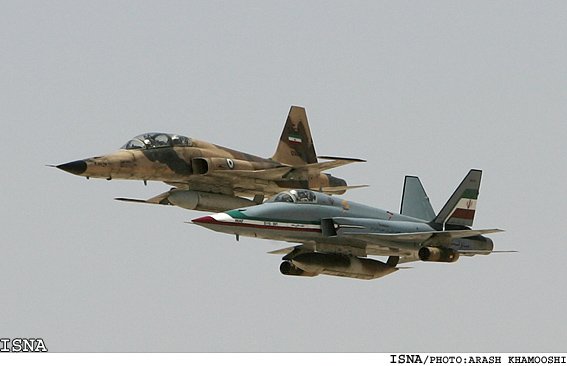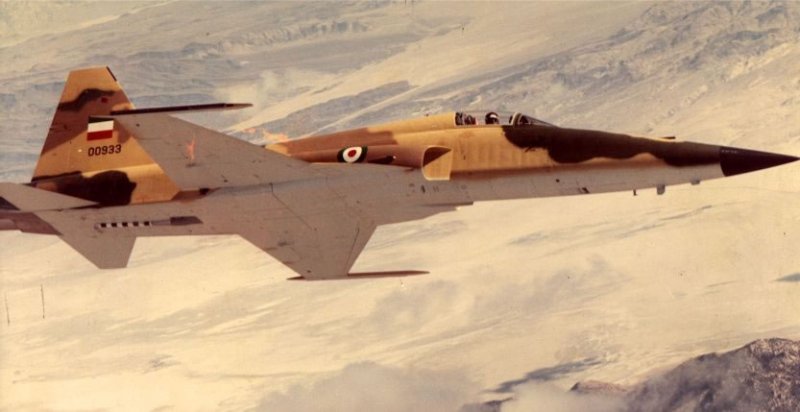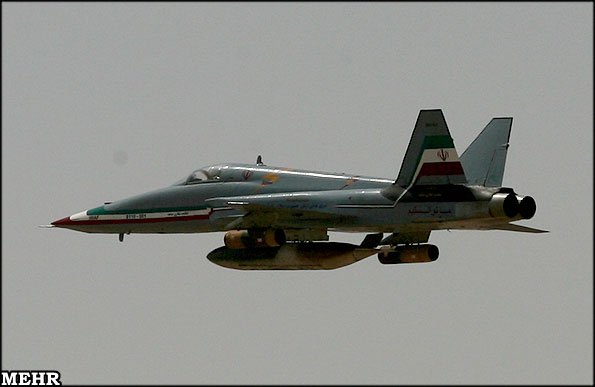


There were reports in the late 1990s of the development of an indigenous fighter design called the Owj (Zenith), although this could have reflected a nomenclature confusion with the IRIAF Owj Industrial Complex. This name was not applied to a publicly displayed aircraft type as of 2008.
In December 1998 Chancellor of Martyr Sattari University, Brigadier General Ali-Akbar Showqi told the President Mohammad Khatami that the fighter Saeqeh (also written Saeqeh, Sa'eqeh, Saegheh, or Saeqeh-80, and alternately translated as Lightning or Thunderbolt), then in the design phase, would do its experimental flight in the year 2001. Although the long-awaited Azarakhsh had yet to enter series production, some reports claimed that IRIAF officials were saying that the service's main indigenous fighter project was actually the Sa'eqeh-80 (lightning), said to be an advanced design twin-fin and twin-engine fighter-interceptor in the class of the F-14 Tomcat. Sa'eqeh-80 was then undergoing wind tunnel tests and is hoped to make its maiden flight in late 2001 or early 2002.
Despite using reverse-engineered parts in the design of Sa'eqeh-80, it was claimed to be original and not similar to any aircraft currently in Iranian service or elsewhere. All the design and prototyping of the new fighter project had reportedly been completed by IRIAF's Sattari Aeronautical University and the Owj Industries." This first prototype's landing gear had been of Polish origin, but Iranian-manufactured landing gear will be installed from second example.
By one account the Shaequeh was originally called the Azarakhsh 2 or Shaequeh-80. The number 80 corresponded to the Iranian year 1380 (2001), which was the originally planned date for the first flight. However, after delays in development, the number 80 was abandoned, and the Saegheh (Thunderbolt) project continued with the alias "Azarakhsh-2".
The Saeqheh is the most advanced F-5 modification project known, intended to learn about the effects of twin tail on the aircraft's performance. It was developed by MATSA Air Force Technology and Electronic Center and the Shahid Sattari Air Force University of Tehran, starting in 1998, first flight occurring on 30 May 2004.
In July 2004 Iran showed a video and pictures of the latest prototype fighter jet, called Saeqeh, or Saeqeh-80 (after the Islamic year 1380). The aircraft resembled an F-5E Tiger II with a pair of canted vertical stabilizers, resembling those of the American F/A-18. The similarities were reinforced by the announcement that this new aicraft was a follow on to the Azarakhsh (Thunder) aircraft, which also bore significant similarities to the F-5E.
The Saeghe-80 (first prototype) featured a double Tail and new afterburners and very similar general lines to the F-5E. The air inlets were classic as in the F-5 style "Coke bottle". By another account the first prototype serial [S110-001] had the "F/A-18" and new square air inlets [other sources call this aircraft the Azarakhsh]. It was known from participation in the exercise "Blow of Zolfaqar", which began on 19 August 2006, carrying out attack missions armed with Multiple Rocket Launcher. Two additional prototypes flew from Tehran on 20 September 2007. The second prototype [S110-002] was photographed landing at Mehrabad on 22 September 2007. The second prototype featured a modified pitot tube, fin attachment to fuselage, normal round air inlets, and new, slightly different paint for each aircraft, similar to the US Blue Angels aerobatic team colors. The three aircraft joined the IRAF on 22 September 2007 when they made their appearance to fly-by at the National Army Day. All three aircraft participated to the same event in the year 2008. In September 2006 Iranian reports said the remodeled plane, called the Thunderbolt (Saequeh, in Persian) was redesigned and upgraded using only Iranian expertise and equipment. The jet carried a locally built missile with the same name. Iran's army chief, Ataollah Salehi, is quoted as saying the new fighter carried out a mock bombing mission in northwestern Iran. He added that Iran received no outside help for the project.
The fighter jet is claimed to be "similar to the F-18 fighter jet, but it is more capable and has been manufactured domestically," the commander of the Iranian army General Attollah Salehi was quoted as saying by the state news agency IRNA. The aircraft presents some alterations in the lines, but the main alteration, consists of the existence of two vertical helms, against only one in the F-5. The installment of the aircraft will not be superior to the ones of the F-5, for the capacity to load armaments also will not be very different. However there is speculation on the capacity that this Saeghe-80 will have in terms of better maneuverability that will be conferred to it by the different lines of the tail and the body of the airplane. The double tail, in the style of American F/A-18 fighter, led to some Iranian reports that technician had constructed an airplane with identical capacities to the ones of the F/A-18, which in reality did not happen. The Saeghe, with the same number of attachment points on the wings and identical configuration, will be able to serve as attack airplane but it will hardly be able to face more sophisticated aircraft. The new design is said to show a significantly improved take-off and turning performance. Depending on the success of the test program, the Sa'eqeh could enter series production, with a digital glass cockpit and other improvements.
On 6 August 2007 the Islamic Republic News Agency (IRNA) had reported Ministry of Defense Mostafa Mohammad-Najjar as saying that successful test of the Azarakhsh would lead to plans for "manufacturing of the fifth generation of Iranian aircraft." Army and Defense Ministry experts were currently working on the second type of Azarakhsh fighters, to be called Saeqeh, which would be also tested in the near future, Mohammad-Najjar added.
Iran's supreme leader Ayatollah Ali Khamenei called for the armed forces to be boosted, as the Islamic republic unveiled the locally developed fighter jet. During his tour of the western city of Hamedan, Khamenei was shown the Saeqeh. The jet had been shown on state television making a test flight. No information about its operational capacity, technical specifications or production were given. In his address to a group of pilots and air force commanders, at the third air force base in Hamedan, Ayatollah Khamenei hailed the key role of the air force. The Supreme Leader said successful manufacture of the Saeqeh jet fighter by the Islamic Republic Iran's Air Aorce and elevation of their combat readiness were the results of their faith, hard endeavors and strong will. The Saeqeh jet fighter made a successful test flight in the presence of the Supreme Leader during the ceremony.
On 23 September 2007 President Mahmoud Ahmadinejad inspected three models of jet fighters -- Saeqeh, Azarakhsh and Tazarv -- Iran Air Force unveiled on the anniversary of the Iraqi invasion of Iran in 1980. He attended the Air Force Base 1 in Southern Tehran to appreciate the technical teams involved in manufacturing the Iranian made jet fighters. Saeqeh and Azarakhsh jet fighters manufactured jointly by the Ministry of Defense and Logistics of the Armed Forces and the Air Force of the Army of the Islamic Republic of Iran are for military missions and Tazarv (pheasant) is for training. President Ahmadinejad expressed pleasure with success of Iranian technicians in manufacturing the planes.
Shaequeh was never powered by RD-33, which is very big engine for the F-5 and woul require a redesign all tail part first. That never happened - it was just rumor.
The Iranian military has introduced a new squadron of domestically-manufactured Saeqeh fighter-bombers to the country's Air Force to strengthen its deterrence power, according to Press TV. This fleet is the first fighter-bomber squadron made up of domestically manufactured aircraft,” a top Air Force officer, Seyyed Mohammad Alavi, explained on 27 February 2010 . “The plane's parts have all been produced inside the country in a joint project between the Defense Ministry and the Air Force,” he added. Alavi did not elaborate on the number of aircraft in the squadron, but said that several new Saeqeh fighters would be added at a later date making a full fleet of 24 aircraft.
Iran unveiled its first squadron of Saeqeh fighter bombers in an air show in September 2010. 'Iran's domestically-made fighters like Azarakhsh (Lightening), Iran 140 and Saeqeh will be used during the air show,' Iranian Air Force Commander Brigadier General Hassan Shahsafi told FNA, noting that the Iranian Army Air Force will display different kinds of fighter-bombers in the parade as well. The parades took place September 22, at the beginning of the Week of Holy Defense, marking Iranian sacrifices during the 8 years of Iraqi imposed war on Iran in 1980s. The large air show is aimed at displaying the defensive power of the Islamic Republic of Iran. Referring to the completion of 'a squadron of Saeqeh fighters' by Iranian experts, Shahsafi reiterated that Iran could boost its position in the arena of aerial power by the move and that Iran's Air Force and Defense Ministry showed their proper management to succeed in such an important and modern field.
A senior commander of the Islamic Republic of Iran Air Force (IRIAF) said Iran plans to carry out technical improvements in the domestically-made Saeqeh (Thunderbolt) warplane. According to IRNA, Deputy Commander of the IRIAF Abdollah Kashanifard said 26 September 2011 that enhancing military capabilities of the aircraft has been put high on the agenda of competent Iranian experts. Kashanifard went on to say that the unique design of the jet fighter, which is a light and efficient aircraft, has facilitated the process of supplying its weapons and accessories. The Iranian commander further explained that the pre-flight preparations for Saeqeh require fewer personnel and take less time in comparison with other types of warplanes. Iranian Defense Minister Brigadier General Ahmad Vahidi announced the addition of three new indigenous Saeqeh (Thunderbolt) fighter jets to the Islamic Republic of Iran Air Force (IRIAF) fleet. “The building and delivery of new fighter jets will take place without delay and according to the preset schedule,” Vahidi said on May 14, 2012. Vahid added that the fighter jets can play an important role in boosting Iran's defense prowess and safeguarding its sovereignty.
A senior commander of the Islamic Republic of Iran Air Force (IRIAF) said 25 September 2012 that a new generation of indigenous Saeqeh fighter jets will join the Iranian Air Force fleet before the end of the year (March 20, 2013.) “The new generation of indigenous Saeqeh fighter jets is being produced and will soon join the Air Force fleet under a new name,” IRIAF Deputy Commander Brigadier General Aziz Nasirzadeh noted on Monday. The commander added that the new fighter jets are more advanced than the current ones and have been optimized by the Iranian specialists. He noted that the new aircraft can be equipped with enhanced ammunitions, smart bombs and modern electronic systems.
In April 2012, IRIAF Deputy Commander for Coordination Brigadier General Aziz Nasirzadeh said the country planned to build a new generation of the Saeqeh fighter jets with enhanced radar systems and smart munitions.
The Islamic Republic of Iran Air Force (IRIAF) claimed to have started the mass production of the indigenous Saeqeh (Thunderbolt) fighter jets. A spokesman for the IRIAF announced on 07 January 2015 that the indigenously developed fighter jet "has already gone through mass production." Brigadier General Hossein Chitforoush said the IRIAF has built squadrons of Saeqeh and they are "going through their evolutionary process." Chitforoush said the fighter is continuously conducting reconnaissance missions across Iran.
In February 2015 Iran unveiled a new version of its supersonic fighter, Saeqeh-2. The aircraft can reportedly be used for combat and tactical missions, as well as advanced pilot training, according to Brigadier General Amir Hatami, Iran’s deputy defense minister. Saeqeh-2 jet is a twin seated aircraft as opposed to the sinngle-seat Saeqeh. Iran’s air force has 18 F-5F fighter jets which can be converted into Saeqeh-2.
